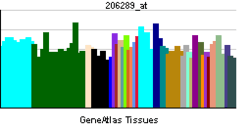HOXA4
| HOXA4 | |||||||||||||||||
|---|---|---|---|---|---|---|---|---|---|---|---|---|---|---|---|---|---|
| Identifiers | |||||||||||||||||
| Aliases | HOXA4, HOX1, HOX1D, homeobox A4 | ||||||||||||||||
| External IDs | MGI: 96176 HomoloGene: 37583 GeneCards: HOXA4 | ||||||||||||||||
| |||||||||||||||||
| RNA expression pattern | |||||||||||||||||
 | |||||||||||||||||
| More reference expression data | |||||||||||||||||
| Orthologs | |||||||||||||||||
| Species | Human | Mouse | |||||||||||||||
| Entrez | |||||||||||||||||
| Ensembl | |||||||||||||||||
| UniProt | |||||||||||||||||
| RefSeq (mRNA) | |||||||||||||||||
| RefSeq (protein) | |||||||||||||||||
| Location (UCSC) | Chr 7: 27.13 – 27.13 Mb | Chr 6: 52.19 – 52.19 Mb | |||||||||||||||
| PubMed search | [1] | [2] | |||||||||||||||
| Wikidata | |||||||||||||||||
| View/Edit Human | View/Edit Mouse |
Homeobox A4, also known as HOXA4, is a protein which in humans is encoded by the HOXA4 gene.[3][4]
Function
In vertebrates, the genes encoding the class of transcription factors called homeobox genes are found in clusters named A, B, C, and D on four separate chromosomes.[5] Expression of these proteins is spatially and temporally regulated during embryonic development. This gene is part of the A cluster on chromosome 7 and encodes a DNA-binding transcription factor which may regulate gene expression, morphogenesis, and differentiation.[3]
See also
References
- ↑ "Human PubMed Reference:".
- ↑ "Mouse PubMed Reference:".
- 1 2 "Entrez Gene: HOXA4 homeobox A4".
- ↑ McAlpine PJ, Shows TB (July 1990). "Nomenclature for human homeobox genes". Genomics. 7 (3): 460. doi:10.1016/0888-7543(90)90186-X. PMID 1973146.
- ↑ Scott MP (November 1992). "Vertebrate homeobox gene nomenclature". Cell. 71 (4): 551–3. doi:10.1016/0092-8674(92)90588-4. PMID 1358459.
Further reading
- Scott MP (1992). "Vertebrate homeobox gene nomenclature.". Cell. 71 (4): 551–3. doi:10.1016/0092-8674(92)90588-4. PMID 1358459.
- Buettner R, Yim SO, Hong YS, et al. (1991). "Alteration of homeobox gene expression by N-ras transformation of PA-1 human teratocarcinoma cells.". Mol. Cell. Biol. 11 (7): 3573–83. PMC 361102
 . PMID 1675427.
. PMID 1675427. - McAlpine PJ, Shows TB (1990). "Nomenclature for human homeobox genes.". Genomics. 7 (3): 460. doi:10.1016/0888-7543(90)90186-X. PMID 1973146.
- Peverali FA, D'Esposito M, Acampora D, et al. (1991). "Expression of HOX homeogenes in human neuroblastoma cell culture lines.". Differentiation. 45 (1): 61–9. doi:10.1111/j.1432-0436.1990.tb00458.x. PMID 1981366.
- Ferguson-Smith AC, Fienberg A, Ruddle FH (1989). "Isolation, chromosomal localization, and nucleotide sequence of the human HOX 1.4 homeobox.". Genomics. 5 (2): 250–8. doi:10.1016/0888-7543(89)90054-2. PMID 2571574.
- Boncinelli E, Acampora D, Pannese M, et al. (1990). "Organization of human class I homeobox genes.". Genome. 31 (2): 745–56. doi:10.1139/g89-133. PMID 2576652.
- Verlinsky Y, Morozov G, Gindilis V, et al. (1995). "Homeobox gene expression in human oocytes and preembryos.". Mol. Reprod. Dev. 41 (2): 127–32. doi:10.1002/mrd.1080410202. PMID 7654365.
- Apiou F, Flagiello D, Cillo C, et al. (1996). "Fine mapping of human HOX gene clusters.". Cytogenet. Cell Genet. 73 (1-2): 114–5. doi:10.1159/000134320. PMID 8646877.
- Kuliev A, Kukharenko V, Morozov G, et al. (1996). "Expression of homebox-containing genes in human preimplantation development and in embryos with chromosomal aneuploidies.". J. Assist. Reprod. Genet. 13 (2): 177–81. doi:10.1007/BF02072541. PMID 8688592.
- Duluc I, Lorentz O, Fritsch C, et al. (1997). "Changing intestinal connective tissue interactions alters homeobox gene expression in epithelial cells.". J. Cell. Sci. 110 (11): 1317–24. PMID 9202392.
- Stelnicki EJ, Kömüves LG, Kwong AO, et al. (1998). "HOX homeobox genes exhibit spatial and temporal changes in expression during human skin development.". J. Invest. Dermatol. 110 (2): 110–5. doi:10.1046/j.1523-1747.1998.00092.x. PMID 9457903.
- Verlinsky Y, Morozov G, Verlinsky O, et al. (1998). "Isolation of cDNA libraries from individual human preimplantation embryos.". Mol. Hum. Reprod. 4 (6): 571–5. doi:10.1093/molehr/4.6.571. PMID 9665340.
- "Toward a complete human genome sequence.". Genome Res. 8 (11): 1097–108. 1999. doi:10.1101/gr.8.11.1097. PMID 9847074.
- Kosaki K, Kosaki R, Suzuki T, et al. (2002). "Complete mutation analysis panel of the 39 human HOX genes.". Teratology. 65 (2): 50–62. doi:10.1002/tera.10009. PMID 11857506.
- Larramendy ML, Niini T, Elonen E, et al. (2003). "Overexpression of translocation-associated fusion genes of FGFRI, MYC, NPMI, and DEK, but absence of the translocations in acute myeloid leukemia. A microarray analysis.". Haematologica. 87 (6): 569–77. PMID 12031912.
- Strausberg RL, Feingold EA, Grouse LH, et al. (2003). "Generation and initial analysis of more than 15,000 full-length human and mouse cDNA sequences.". Proc. Natl. Acad. Sci. U.S.A. 99 (26): 16899–903. doi:10.1073/pnas.242603899. PMC 139241
 . PMID 12477932.
. PMID 12477932. - Méchine-Neuville A, Lefebvre O, Bellocq JP, et al. (2003). "[Increased expression of HOXA9 gene in Hirschsprung disease]". Gastroenterol. Clin. Biol. 26 (12): 1110–7. PMID 12520199.
- Hillier LW, Fulton RS, Fulton LA, et al. (2003). "The DNA sequence of human chromosome 7.". Nature. 424 (6945): 157–64. doi:10.1038/nature01782. PMID 12853948.
- Strathdee G, Sim A, Parker A, et al. (2007). "Promoter hypermethylation silences expression of the HoxA4 gene and correlates with IgVh mutational status in CLL.". Leukemia. 20 (7): 1326–9. doi:10.1038/sj.leu.2404254. PMID 16688227.
External links
- HOXA4 protein, human at the US National Library of Medicine Medical Subject Headings (MeSH)
This article incorporates text from the United States National Library of Medicine, which is in the public domain.